Kalanchoe luciae ssp. luciae
| Botanical Name | Kalanchoe luciae ssp. luciae |
|||||||||||||||||||||
| Family | Crassulaceae - The crassula family. |
|||||||||||||||||||||
| Pronunciation | kal-un-KOH-ee LOO-see-ay |
|||||||||||||||||||||
| Common Name(s) |
USA: Flapjack plant; Pancake plant
|
|||||||||||||||||||||
| Plant Group |
|
|||||||||||||||||||||
| Plant Size |
|
|||||||||||||||||||||
| Position |
|
|||||||||||||||||||||
| General Information |
|
|||||||||||||||||||||
| Specific Information | Kalanchoe luciae ssp. luciae has large, thick, spatula- to almost circular-shaped leaves that have a broad reddish blush along the margins. The younger leaves and stems have a white, floury coating which is a protection from harsh sun. The younger inner leaves are upright and parallel to each other like stacked dinner plates and older leaves angle slightly outwards, often developing wavy edges. Kalanchoe luciae flowers during the third or fourth season, after which the plant dies. However, the plant produces numerous offsets throughout its life, ensuring that there are always replacements. The plant can also be grown in shade where the leaves lose most of their colour but are useful for form and texture. Direct sun and dry conditions enhance the colors of the succulent. Suitable for hardiness zones 9 through 11. A frequent error in identification is often made between Kalanchoe luciae and Kalanchoe thrysiflora, especially prevalent in the USA and Europe but rearing its head locally as well: The two species are closely related, both species having fleshy, paddle-like leaves but the leaves of Kalanchoe thyrsiflora are a chalky green with red colouring only if very stressed, are somewhat narrower, grow up the main stem and are liberally coated with a thick flour-like wax. The leaves of Kalanchoe lucia are rounded, have a broad red edge, cluster close to each other at ground level and have no floury coating on mature leaves. The flowers of the two species also differ. Those of Kalanchoe luciae are only mildly scented and have an urn-shaped flower tubes with greenish-yellow petals, while those of Kalanchoe thyrsiflora are heavily sweetly scented with a cylindrical flower tube and bright yellow petals. Go to http://www.ispot.org.za/search/node/kalanchoe%20thyrsiflora for pictures of Kalanchoe thyrsiflora |
|||||||||||||||||||||
| Ad Break | ||||||||||||||||||||||
| Flowers | ||||||||||||||||||||||
| Description | tall stem of 1 to 1.5 m, with densely clustered urn-shaped flower tubes from which 4 pointed petals emerge |
|||||||||||||||||||||
| Season |
|
|||||||||||||||||||||
| Colour |
|
|||||||||||||||||||||
| Growth Rate |
|
|||||||||||||||||||||
| Plant Uses |
|
|||||||||||||||||||||
| Distribution and Habitat | in the provinces of KwaZulu-Natal, Limpopo, Mpumalanga, North West and Gauteng, on escarpments and foothills in bushveld, in open, rocky situations and on exposed hilltops |
|||||||||||||||||||||
| Planting Suggestions | Plant Kalanchoe luciae in a sunny,dry spot in well-drained soil. Do not over-water as the bright red colour will fade. They are easily propagated by gently easing the off-sets produced below the mother plant. Dry the plantlets for a day and then plant shallowly straight into the garden where you want them to grow. They can also repotedly be propagated by leaf, but make sure that a small piece of stem is attached at the base of the leaf. Kalanchoe luciae is tolerant of a wide range of soils, including salty soils, as long as drainage is good - very wet or soggy soil will cause the roots to rot. Once established, Kalanchoe luciae is very drought tolerant and requires little watering. |
|||||||||||||||||||||
| Medicinal Uses | No data found. |
|||||||||||||||||||||
| Ad Break | ||||||||||||||||||||||


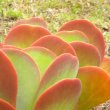
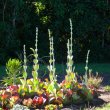

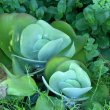
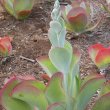
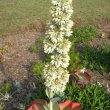
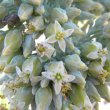
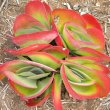


Comments
my kalanchoe luciae was fit hard by the cold weather
I covered the plants up but the Cold so got to this one. The offshoots are fine, but is there anything I can do for mother plant?
Cold damage to Kalanchoe luciae
Hi Cindy
Apologies for taking so long to answer you. By now you will probably have found that there is very little you can do to prevent the leaves from dying. The main thing to look out for is the rot that often follows this kind of damage, especially if the leaves had actually been frozen. I would first cut away the leaves that have been affected. If any part of the base shows evidence of soft or slimy material, lift the plant and ruthlessly cut away ALL signs of rot. Leave the remains of the plant in a dry, shady spot - about a week should do - until all cuts have dried out and formed a strong scab over the cut areas. The plant can then be placed back in the ground, where it should start to sent up offshoots.
If there is no sign of rotting, just cut away the affected leaves and the plant will send up new shoots.
Kind regards
Lorraine
unaffected kalanchoe luciae leaves
Can I just plant the leaves in the dirt once they heal over? Of do I need to wait till they start to sprout?
Leaf propagation of Kalanchoe luciae
Hi Cindy
I have grown dozens of species of succulents from leaves but I have never had success in propagating this plant from a leaf, neither have I seen it do so on its own, like so many other succulents do. All my attempts have resulted in the leaf drying out until it is crisp - with no hint of rooting or budding. Perhaps you will have the right touch.
To root a succulent leaf, the leaf must be removed intact from the stem, ensuring that you include the part of the leaf where it attaches to the stem, and even a tiny piece of the stem itself, where possible. (Without this material attached it is highly unlikely that the leaf will root.) Allow the moist edge to dry in a shady spot for a couple of days or longer, so that the edge is properly scabbed over.
The leaf is then placed onto a sandy soil mix. The base of the leaf must not be buried at all. The base is pressed down so that it settles into a shallow depression and a sprinkling of sand can be scattered over this if you wish.
Keep the soil moist but never wet and allow it to dry between waterings. Water frugally and carefully so as not to dislodge any delicate rootlets that are trying to take hold. A spray bottle works best. Keep the container in a bright, lightly shaded, warm place until rooting and sprouting has occurred.
Once the plantlets are big enough to handle without breaking them, harden them off by putting them in a place where they get some direct sun. Once they are fully hardened, you can replant into their final container.
Hope this helps and please let me know what happens. I would love to know, whether you are successful or not.
Kind regards
Lorraine
leaves
I will gladly let you know. Even if nothing else the offshoots age doing great. I watered it when I replanted then (they where still attached to the main root ball) let the pot drain fully outside if a shady spot before bringing it in. I figured I would water it again in valentines day. I look at it this way if the leaves don't do anything I will have the off shoots.I have a lot of success with my ghost plant. In fact that thing has propagated so much I have little plants everywhere.Same with my Hens and chicks. My topsie turvy plant has pups too. So this paddle plant is a new one for me. I get some nice weather I have three other plants I have no idea what they are and i will take pics and post them but they seem to be doing good. Thank you for all your help.
Sincerely
Cindy
Snail on plant
I have a problem. Just found a snail on my Kalanchoe luciae. I knocked it out of the pot, doused the snail with salt water and sprayed the plant with a 50/50 vinegar-water solution. This was one snail, but is it a harbinger of more to come?
Snails
Hi Sharon
Where there is one snail, there are usually more, but don't despair. Just keep an eye open and pick off any you see. The best way of luring them out into the open is to sprinkle the plants in the area with water in the evening and go out with a torch later on. I put a few of slices of cucumber on the ground among my strawberries - they bypass the strawberries to get at the cucumber and it is easy to collect them. During the day they will hide in dark corners so look behind pots, in corners of walls and beneath ground covers.
A couple of years ago I had a sudden plague of snails in one of my garden beds. With dogged persistence I went out night after night with my torch and collected them by hand - five large coffee tins full - adding up to around 3000 snails. It paid off as they had no chance of laying eggs and the bed is clear of snails, until the next time!
Your plant looks very healthy but I would like to suggest that you give it a little less water and a lot more sun. That will encourage it to have more compact growth and the leaves will have a much redder colour.
Kind regards
Lorraine
Medicinal uses for Kalanchoe
A blade or leaf of this plant is used for corns on the feet. Put it inside a sock and leave overnight. It works very fast and after a week the corn usually dissapears completely.
Discuss this plant
Share knowledge, ask a question or give an experience.